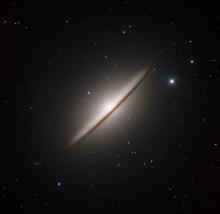Listen to today's episode of StarDate on the web the same day it airs in high-quality streaming audio without any extra ads or announcements. Choose a $8 one-month pass, or listen every day for a year for just $30.
You are here
Middleweight Black Hole
Every big galaxy is thought to have a big black hole at its heart. But just how those black holes were born is the subject of a lively debate. Some say the black holes formed from the collapse of giant clouds of gas. Others say they formed from “seed” black holes a few thousand times as massive as the Sun. But such black holes have been hard to find; astronomers have evidence for only a handful of them.
The most recent is in a star cluster known as 47 Tucanae. It’s in the far-southern constellation Tucana, the toucan. The cluster contains hundreds of thousands of stars, all packed into a ball about a hundred light-years across.
Several previous searches had found no evidence of an intermediate-mass black hole in the cluster.
But a new search took a different approach from the others. It measured the overall motion of stars within the cluster, as well as the orbits of pulsars — stellar corpses that emit regular pulses of energy. Both types of stars should sink to the center of the cluster. But examples of both were found well outside the center. That suggests something is stirring up the center, kicking heavy stars into unusually wide orbits.
By comparing these observations to mathematical models, researchers concluded that a black hole more than 2,000 times the mass of the Sun sits at the cluster’s heart.
If the finding is confirmed, it could provide good evidence that giant black holes can grow from medium-sized ones.
Script by Damond Benningfield





